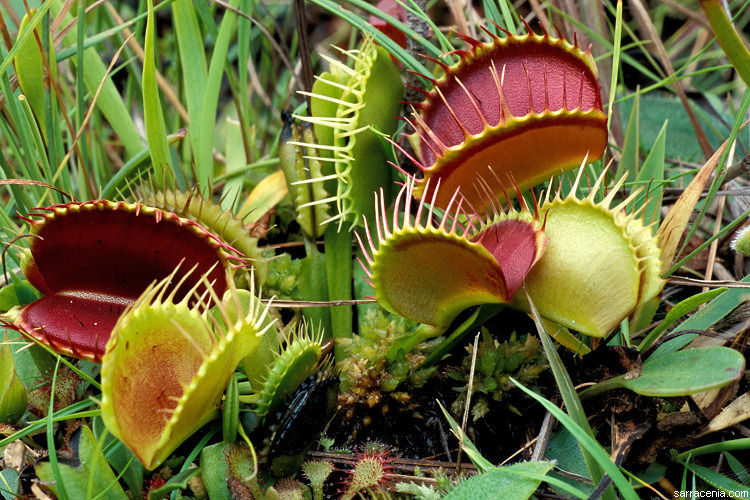Zen and the Art of Gardening

Venus Flytrap
Dionaea muscipula
Height: 6′
Cold Resistance: 5F.
Light:Sun to light shade.
The Venus Flytrap, Dionaea muscipula is the only carnivorous plant of it’s type. It is the only species in it’s genus but there are many forms and cultivars. It’s native habitat is in the Carolinas of the eastern U. S. It grows in bog areas that are very acidic with no nutrients in the soil. By catching and digesting insects and other small invertebrate these carnivorous plants are able to obtain the nutrients they need to thrive. The plants are dormant in the winter and do not produce new traps, or only produce them very slowly. New traps are produced in the spring and summer. With lots of sun most Venus Flytraps will be green but have some color to them. There are many species available with varying degrees of red color, some are entirely red. Plants usually produce a stem with white flowers. These really are pretty in the bog garden. The plants must have a dormant winter period or they will not thrive and will slowly decline. How the Venus Flytrap Works The trap has two parts that are hinged on one side. The other side has quarter inch spines which form a barrier when closed.Inside the trap there are 3 “trigger” hairs on each half. In order to trigger the closing mechanism the prey must touch at least two hairs or one of the hairs twice.The trap closes very fast. If the hairs are not triggered again once the trap closes,it will re-open. This is to prevent the plant from wasting energy trying to digest rain drops or debris. With an insect that continues to move and touch the hairs the trap closes tighter. The spines prevent the insect from escaping during this struggle.The plant begins to digest the insect at this point by releasing digestive enzymes. The nutrients from the insect are absorbed by the trap. It will take 4 to 6 days for the trap to finish the process and re-open. Growing the Venus Flytrap These plants need as much direct sunlight as possible. If grown indoors place them in a south facing window. If you do growthe plant indoors don’t forget that they must have a cold, dormant period in the winter. A mix of one part peat moss and one part sand(make sure the sand does not have lime in it)or perlite is an ideal growing medium. DO NOT grow in regular potting soil as it may contain nutrients which will harm or kill the plant. This means you do not fertilize! The plant gets it’s nutrientsfrom the prey it captures. The container should be plastic because clay pots absorb salts or minerals that may leach back into the soil. Place the container in a tray or saucer with about 1/2 inch of water. Rain water is best or distilled water. It is not the chlorine in tap water that is the problem, it is the mineral or salts. The most important thing is to NOT use hard water. I use the water from a de-humidifier or the condensation from an air conditioner unit. This is water taken from the air and is ideal. Although it’s tempting to trigger the traps this should be kept to a minimum as it uses a lot of energy. If you want to feed the plant use live insects not hamburger or other scraps of food! You can trim off dead, brown traps. If the plant produces a flower stalk you may want to trim it off as it uses a lot of energy to produce the flower and seed.
Lorem ipsum dolor sit amet, consectetur adipiscing elit. Ut elit tellus, luctus nec ullamcorper mattis, pulvinar dapibus leo.


Terms of Service
Privacy Policy
Hardiness Zones
Photos
About Us
Copyright © BigPlants.com
James Mortensen